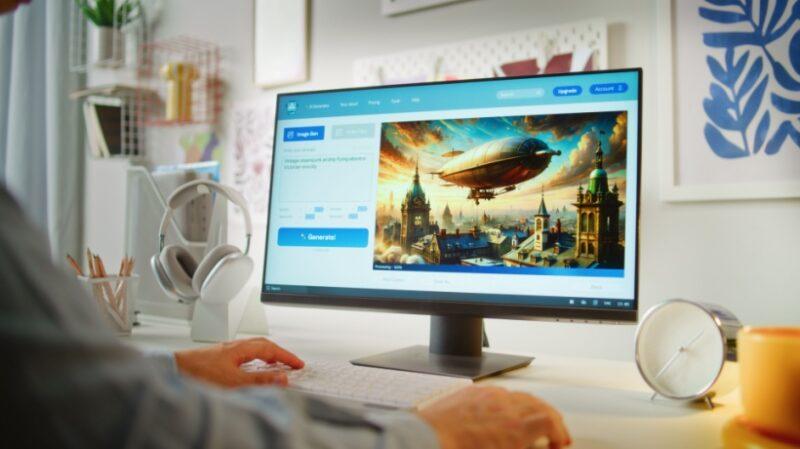
The rise of AI in L&D
AI is becoming part of learning and development (L&D) to create visuals and texts, particularly for modern e-learning programs. But why are AI image generators useful tools for educational designers and e-learning experts? In eLearning, visuals are an important component. Research shows learners remember more when the information they receive is accompanied by images, videos, infographics, or animations. This is because visuals simplify complex ideas and make the experience more enjoyable.
As e-learning evolves to become more interactive and personalized, the visuals need to continue. With e-learning trends such as microlearning, gamification, and storytelling increasingly being adopted in online courses, L&D pros need to keep up. Until recently, many L&D teams used stock images or graphic designers. However, these options have limitations. Stock images often feel generic, custom design takes time and may not always be affordable or available to graphic designers. This is why the industry decided to try out AI image generators.
These tools create visuals based on simple text prompts. For example, you could type “A cheerful office setting where colleagues are chatting around the table.” AI creates images that fit the description. It works by using machine learning models that are trained on a large amount of images. These are extremely useful for designing training content, gamification elements, or other materials that usually take several hours to design. Many of these tools offer platforms and free plans already used by the L&D team, or even more, so it’s easy to try them out without spending too much money. Below, dive into all the benefits and challenges of using AI-generated images with eLearning. This way you can decide for yourself whether they are worth using in your program.
Benefits of using AI Image Generators in L&D
speed
Search many stock photo libraries or create training visuals that mean your design team is waiting for you to submit your work. Of course, this can take days or weeks. Now, using the AI Image Generator, you can create images immediately. Simply enter what you want to see and your image will be prepared immediately. Whether you need photos of healthcare workers who support patients or statistically packed infographic photos, all you have to do is explain it, and AI handles it. This is very useful for the L&D team, especially when the project changes suddenly.
Customization
Personalization is one of the most effective strategies in L&D, and AI-generated images make it even easier. Instead of using common images, you can now create photos that represent actual learners, including roles, tools, and cultural backgrounds. For example, when designing training courses for the global workforce, AI tools can help you create visuals depicting different locations, workplace cultures, and even clothing styles. You can also check that the visual matches your brand. If you want to use branded colors and tones, AI can generate graphics that suit your style. This allows you to maintain a consistent look across all your training modules, even without an in-house designer.
Cost-effective
Hiring people to design illustrations is expensive. Even stock photo subscriptions can be expensive, especially if you use a lot of images. Thankfully, AI Image Generators are useful when you’re on a low budget. Instead of spending money on many images or waiting for designers, you can create the images you need whenever you need them, often at a lower cost. Many AI tools have a usage fee, especially for more advanced ones. However, comparing these costs with traditional methods can save you a lot of money over time. Needless to say, some tools may allow you to create images for free within your daily limits.
Comprehensive and diverse visuals
Stock Photos have been improved, but they often still lack true diversity and expression. On the other hand, AI image generators allow you to create visuals that show diversity, including race, gender, age, ability, body type, and more. This is important. This is because representatives of the training materials help learners feel seen and appreciated. It makes them feel safer, and they are more relevant in the learning content and lead to better learning outcomes. However, it is important to use these tools carefully. AI models can be biased, but when used thoughtfully, they can provide more control than stock libraries.
Creation flexibility
AI Image Generators offer a lot of creative freedom. You’d have struggled to find an image that portrays the exact idea you have in mind, especially if it’s about vague concepts like empathy or data privacy. AI allows you to turn abstract concepts into visuals. This flexibility allows you to connect with learners and also enhances storytelling, the key to effective learning.
What challenges do L&D Pro face when using AI Image Generators?
Inaccurate
One of the well-known problems with AI image generators is their inaccuracy, especially when it comes to depicting people’s anatomy and words and phrases. For example, you might request the image of a professional woman giving a presentation, but it could result in a background with six fingers or fake letters. AI image generators are getting better, but often struggle with small details, especially with complex scenes and realistic images. This is important for e-learning. Visual mistakes can be deflecting learners and making modules appear unprofessional.
Contradiction
The main challenge of AI-generated images is their inconsistency. These tools struggle to create the same person, settings, or style at various prompts. This can be a pain when you want to use the same characters within your course to build storytelling. Some platforms allow you to use reference images, but this may take some time.
bias
When using AI image generators, beware of bias and expressions. These tools learn from data found online and can lead to unintended stereotypes and lack of diversity. For example, you may see certain jobs that are constantly shown by a particular gender or ethnicity. Therefore, it is important to review the images you have created and always consider the people you want to describe as value.
Training time
While AI Image Generators may seem easy to use, many new users will find that they need skills to create the right prompt. You need to explain exactly what you want, including style, angle, color, emotions, activities and more. This requires some practice. Learning to use these tools can be challenging, especially for L&D teams with often tight deadlines. Spending time finding a prompt or testing multiple options to find one good image can be frustrating. Additionally, you may need to edit the final image to suit your brand or fix minor issues. This means that the team needs to spend time learning before creating images generated for satisfying AI.
Intellectual Property Issues
Who owns the images generated by AI tools? Some AI models learn from large datasets obtained from the Internet. This may include copyrighted images. This is especially dangerous for businesses with strict legal regulations. Therefore, if you are creating healthcare or financial images, it is important to make sure that you are allowed. To be safe, use tools that clearly state where your training data comes from, and always read the terms and conditions before sharing images generated to AI.
Privacy concerns
When using AI, you need to pay particular attention to privacy. You may think it’s harmless to personalize content using real learner or employee data, but open AI platforms can store or process this information elsewhere. This is a major risk of exposing sensitive data. Instead, use fake names or common examples when writing the prompt. And don’t forget to always check with your IT or legal team to see what is allowed.
Conclusion
AI Image Generators are powerful, but not magic. They work best when applying your creativity and don’t replace it. This means you need to guide the process. So consider trying out a trial project first. Use AI to create visuals for one lesson or module to see how learners respond and how they fit into their tasks. The final decision is yours, but it’s best to first weigh both the options and challenges before deciding on the image generated by AI.


